 Launch of HMS Queen Mary beneath the distinctive gantry cranes of Palmers' yard | |
| Type | Public |
|---|---|
| Industry | Shipbuilding |
| Founded | 1852 |
| Fate | Collapsed 1933 |
| Successor | Armstrong Whitworth |
| Headquarters | Jarrow, UK |
Palmers Shipbuilding and Iron Company Limited, often referred to simply as "Palmers", was a British shipbuilding company. The Company was based in Jarrow, County Durham, in north-eastern England, and also had operations in Hebburn and Willington Quay on the River Tyne.
History
Early history and growth


The company was established in 1852 by Charles Mark Palmer as Palmer Brothers & Co. in Jarrow.[1] Later that year it launched the John Bowes, the first iron screw collier.[1][2] By 1900 the business was known as Palmers Shipbuilding and Iron Company.[3][Fn 1] At that time, besides building ships, it manufactured and processed its own steel and other metals, and its products included Reed water tube boilers and marine steam engines.[6][Fn 2] By 1902 Palmers' base at Jarrow occupied about 100 acres (41 hectares) and included 0.75 miles (1.2 kilometres) of the southern bank of the River Tyne, and employed about 10,000 men and boys.[8] In 1910 Sir Charles Palmer's interest in the business was acquired by Lord Furness who, as Chairman, expanded the business by acquiring a lease over a new graving dock at Hebburn from Robert Stephenson and Company.[9] In 1919 Palmers laid down the SS Gairsoppa, which was sunk by a German U-boat in 1941, causing the loss of 84 lives and 200 long tons (203 tonnes) of silver.[10][11]
Depression and collapse
The Great Depression, which began in 1929, all but destroyed the shipbuilding industry, which would not rebound until the Second World War. In 1931, Palmers posted a loss of £88,867 (equivalent to £6,424,000 in 2021). The company received a moratorium from its creditors in order to extend repayment. In January 1933, the majority of the company's unsecured creditors met in London and agreed to extend the moratorium a further six months.[12]
However, Palmers' was unable to survive and collapsed by the end of the year. The company's blast furnaces and steel works—which covered 37 acres—were put up for auction.[13] The Jarrow yard was sold to National Shipbuilders Securities, which closed it down in order to sell it, causing much unemployment and leading to the Jarrow March.[14] After the shipyard closed, following support from the industrialist, Sir John Jarvis, the site was used the engine shop as a steel foundry for another 18 months.[15]
The company retained the yard at Hebburn and was subsequently acquired by Armstrong Whitworth, becoming Palmers Hebburn Company.[16] In 1973, Vickers-Armstrongs, successor to Armstrong Whitworth, sold the Palmers Dock at Hebburn to Swan Hunter and developed it as the Hebburn Shipbuilding Dock.[17] This facility was acquired in turn from the receivers of Swan Hunter by Tyne Tees Dockyard in 1994, which sold it to Cammell Laird in 1995. When the latter entered receivership in 2001, the dock was acquired by A&P Group.[18][19] The yard remains in use as a ship repair and refurbishment facility.[20]
Ships built by Palmers Shipbuilding and Iron Company
Ships built by Palmers included:
Naval
Battlecruisers
- HMS Queen Mary
 Royal Navy (1912)
Royal Navy (1912)
Battleships
_after_1866.jpg.webp)
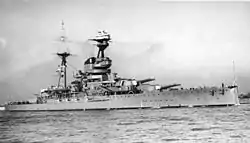
- HMS Defence
 Royal Navy (1861)
Royal Navy (1861) - HMS Hercules
 Royal Navy (1910)
Royal Navy (1910) - HMS Lord Nelson
 Royal Navy (1906)
Royal Navy (1906) - HMS Resolution
 Royal Navy (1892)
Royal Navy (1892) - HMS Resolution
 Royal Navy (1915)
Royal Navy (1915) - HMS Revenge
 Royal Navy (1892)
Royal Navy (1892) - HMS Russell
 Royal Navy (1901)
Royal Navy (1901) - HMS Swiftsure
 Royal Navy (1870)
Royal Navy (1870) - HMS Terror
 Royal Navy (1856)
Royal Navy (1856) - HMS Triumph
 Royal Navy (1870)
Royal Navy (1870)
Cruisers
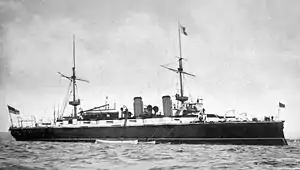
- HMS Alacrity
 Royal Navy (1885)
Royal Navy (1885) - HMS Dauntless
 Royal Navy (1918)
Royal Navy (1918) - HMS Orlando
 Royal Navy (1886)
Royal Navy (1886) - HMS Pegasus
 Royal Navy (1897)
Royal Navy (1897) - HMS Pique
 Royal Navy (1890)
Royal Navy (1890) - HMS Pyramus
 Royal Navy (1897)
Royal Navy (1897) - HMCS Rainbow
 Royal Canadian Navy (1891)
Royal Canadian Navy (1891) - HMS Retribution
 Royal Navy (1891)
Royal Navy (1891) - HMS Surprise
 Royal Navy (1885)
Royal Navy (1885) - HMS Undaunted
 Royal Navy (1886)
Royal Navy (1886) - HMS York
 Royal Navy (1928)
Royal Navy (1928)
Destroyers
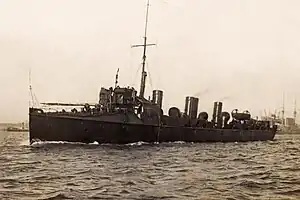
.jpg.webp)
- HMS Bat
 Royal Navy (1896)
Royal Navy (1896) - HMS Chamois
 Royal Navy (1896)
Royal Navy (1896) - HMS Cherwell
 Royal Navy (1903)
Royal Navy (1903) - HMS Crane
 Royal Navy (1896)
Royal Navy (1896) - HMS Dee
 Royal Navy (1903)
Royal Navy (1903) - HMS Diana
 Royal Navy (1932)
Royal Navy (1932) - HMS Duchess
 Royal Navy (1932)
Royal Navy (1932) - HMS Erne
 Royal Navy (1903)
Royal Navy (1903) - HMS Exe
 Royal Navy (1903)
Royal Navy (1903) - HMS Ettrick
 Royal Navy (1903)
Royal Navy (1903) - HMS Fawn
 Royal Navy (1897)
Royal Navy (1897) - HMS Flirt
 Royal Navy (1897)
Royal Navy (1897) - HMS Flying Fish
 Royal Navy (1897)
Royal Navy (1897) - HMS Janus
 Royal Navy (1895)
Royal Navy (1895) - HMS Kangaroo
 Royal Navy (1900)
Royal Navy (1900) - HMS Lightning
 Royal Navy (1895)
Royal Navy (1895) - HMCS Margaree
 Royal Canadian Navy (1932)
Royal Canadian Navy (1932) - HMS Myrmidon
 Royal Navy (1900)
Royal Navy (1900) - HMS Peterel
 Royal Navy (1899)
Royal Navy (1899) - HMS Porcupine
 Royal Navy (1895)
Royal Navy (1895) - HMS Rother
 Royal Navy (1904)
Royal Navy (1904) - HMS Spiteful
 Royal Navy (1899)
Royal Navy (1899) - HMS Star
 Royal Navy (1896)
Royal Navy (1896) - HMS Swale
 Royal Navy (1905)
Royal Navy (1905) - HMS Syren
 Royal Navy (1900)
Royal Navy (1900) - HMS Ure
 Royal Navy (1904)
Royal Navy (1904) - HMS Wear
 Royal Navy (1905)
Royal Navy (1905) - HMS Whiting
 Royal Navy (1896)
Royal Navy (1896) - HMS Wryneck
 Royal Navy (1918)
Royal Navy (1918)
Monitors
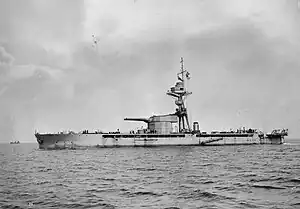
- HMVS Cerberus
.svg.png.webp) Victorian Navy (1868)
Victorian Navy (1868) - HMS General Wolfe
 Royal Navy (1915)
Royal Navy (1915) - HMS Gorgon
 Royal Navy (1871)
Royal Navy (1871) - HMS Marshal Ney
 Royal Navy (1915)
Royal Navy (1915) - HMS Marshal Soult
 Royal Navy (1915)
Royal Navy (1915)
River gunboats
.jpg.webp)
- HMS Dee
 Royal Navy (1877)
Royal Navy (1877) - HMS Don
 Royal Navy (1877)
Royal Navy (1877) - HMS Esk
 Royal Navy (1877)
Royal Navy (1877) - HMS Medina
 Royal Navy (1876)
Royal Navy (1876) - HMS Medway
 Royal Navy (1876)
Royal Navy (1876) - SMS Planet
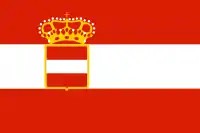 Austro-Hungarian Navy (1889)
Austro-Hungarian Navy (1889) - HMS Sabrina
 Royal Navy (1876)
Royal Navy (1876) - HMS Slaney
 Royal Navy (1877)
Royal Navy (1877) - HMS Spey
 Royal Navy (1876)
Royal Navy (1876) - HMS Tay
 Royal Navy (1876)
Royal Navy (1876) - HMS Tees
 Royal Navy (1876)
Royal Navy (1876) - HMS Trent
 Royal Navy (1877)
Royal Navy (1877) - HMS Tweed
 Royal Navy (1877)
Royal Navy (1877)
Merchant and leisure
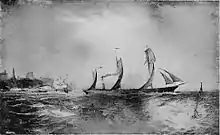

Cable ships
Cargo ships
- Anne Thomas
 Evan Thomas Radcliffe (1882)
Evan Thomas Radcliffe (1882) - Anthony Radcliffe
 Evan Thomas Radcliffe (1893)
Evan Thomas Radcliffe (1893) - Automedon
 Alfred Holt and Company (1922)
Alfred Holt and Company (1922) - Clarrisa Radcliffe
 Evan Thomas Radcliffe (1889)
Evan Thomas Radcliffe (1889) - Douglas Hill
 Evan Thomas Radcliffe (1890)
Evan Thomas Radcliffe (1890) - Gairsoppa
 British-India Steam Navigation Company (1919)
British-India Steam Navigation Company (1919) - Gwenllian Thomas
 Evan Thomas Radcliffe (1882)
Evan Thomas Radcliffe (1882) - Iolo Morganwg
 Evan Thomas Radcliffe (1882)
Evan Thomas Radcliffe (1882) - John Bowes
 Charles Palmer (1852)[21]
Charles Palmer (1852)[21] - Kate Thomas
 Evan Thomas Radcliffe (1884)
Evan Thomas Radcliffe (1884) - Lady Palmer
 Evan Thomas Radcliffe (1889)
Evan Thomas Radcliffe (1889) - Mary Thomas
 Evan Thomas Radcliffe (1889)
Evan Thomas Radcliffe (1889) - Meriones
 China Mutual Steam Navigation Company (1922)
China Mutual Steam Navigation Company (1922) - Slavic Prince (Prince Line Ltd, Newcastle) (1918)
Oil tankers
- British Ardour
 British Tanker Company (1928)
British Tanker Company (1928) - British Aviator
 British Tanker Company (1924)
British Tanker Company (1924) - British Captain
 British Tanker Company (1923)
British Tanker Company (1923) - British Chemist
 British Tanker Company (1925)
British Tanker Company (1925) - British Chivalry
 British Tanker Company (1929)
British Tanker Company (1929) - British Corporal
 British Tanker Company (1922)
British Tanker Company (1922) - British Freedom
 British Tanker Company (1928)
British Tanker Company (1928) - British General
 British Tanker Company (1922)
British Tanker Company (1922) - British Honour
 British Tanker Company (1928)
British Tanker Company (1928) - British Industry
 British Tanker Company (1927)
British Tanker Company (1927) - British Inventor
 British Tanker Company (1926)[22]
British Tanker Company (1926)[22] - British Justice
 British Tanker Company (1928)
British Tanker Company (1928) - British Light
 British Tanker Company (1917)
British Tanker Company (1917) - British Loyalty
 British Tanker Company (1928)
British Tanker Company (1928) - British Mariner
 British Tanker Company (1922)
British Tanker Company (1922) - British Officer
 British Tanker Company (1922)
British Tanker Company (1922) - British Premier
 British Tanker Company (1922)
British Tanker Company (1922) - British Science
 British Tanker Company (1931)
British Tanker Company (1931) - British Sergeant
 British Tanker Company (1922)
British Tanker Company (1922) - British Splendour
 British Tanker Company (1931)
British Tanker Company (1931) - British Strength
 British Tanker Company (1931)
British Tanker Company (1931) - British Yeoman
 British Tanker Company (1923)
British Tanker Company (1923)
Passenger ships
- SS Connaught (1860)
- SS Armenia (1896)
- SS Nevada (1868)[23]
Steam yachts
Tugs
Cargo vessels
- S.S. Socotra, 1897
See also
References
Footnotes
- ↑ Some 19th-century and later sources refer to the company as "Palmer's Shipbuilding and Iron Company", with an apostrophe, but in Some Account of the Works of Palmers Shipbuilding & Iron Company Limited, which was compiled by the business's company secretary Malcom Dillon and published in 1900, the name is given throughout as "Palmers ...", without the apostrophe.[4][5][3]
- ↑ "A speciality of [Palmers' engine works] is the manufacture of the 'Reed' water-tube boiler, the invention of Mr J. W. Reed, manager of the engine works department, which has been adopted with well-known results in ... high-speed [torpedo boat destroyers] ..., and also in vessels constructed for the Admiralty on the Clyde. It may be observed that nearly 25 miles [40 km] of tubes are used in the manufacture of the boilers and machinery of each 30-knot destroyer."[7]
Notes
- 1 2 "Building for the world". The Journal. 22 May 2007. Retrieved 10 November 2012.
- ↑ Dillon 1900, pp. 16–7.
- 1 2 Dillon 1900.
- ↑ Gibbs 1896, p. 8.
- ↑ Anon. 1899, p. 475.
- ↑ Dillon 1900, pp. 28–50.
- ↑ Dillon 1900, pp. 33–4.
- ↑ Anon. 1902, pp. 613, 616.
- ↑ "Christopher Furness, Obituary". The Times. 11 November 1912. Retrieved 10 November 2012.
- ↑ "Shipwreck of SS Gairsoppa reveals £150m silver haul". BBC News. 26 September 2011. Archived from the original on 26 November 2016. Retrieved 10 February 2017.
- ↑ C. Michael Hogan (Lead Author); Peter Saundry (Topic Editor) (21 May 2012). Cleveland, Cutler J (ed.). "SS Gairsoppa recovery". Encyclopedia of Earth. Washington, D.C.: Environmental Information Coalition, National Council for Science and the Environment. Archived from the original on 4 November 2013. Retrieved 10 February 2017.
{{cite journal}}:|author1=has generic name (help) - ↑ "Palmers' Moratorium". Sunderland Daily Echo and Shipping Gazette. 14 January 1933. Retrieved 12 August 2017.
- ↑ "Steel Works to be Sold at Auction". The Times. 10 July 1934. p. 11.
- ↑ Charles Palmer Archived 8 February 2009 at the Wayback Machine
- ↑ "Palmers Shipbuilding and Iron Company". Grace's Guide. Retrieved 3 April 2021.
- ↑ Crockett, Margaret; Foster, Janet (October 2005). "Report on the Access to Shipbuilding Collections in North East England (ARK) Project" (PDF). Tyne & Wear Archives. Archived from the original (PDF) on 3 November 2013. Retrieved 10 November 2012.
- ↑ "Swan Hunter History: Naval ships". swanhunter.com. 2010. Archived from the original on 22 February 2012. Retrieved 10 November 2012.
- ↑ "Shipbuilder: Palmers Hebburn Co Ltd, Hebburn (1934 – 1973)". Tyne Built Ships. n.d. Archived from the original on 1 March 2014. Retrieved 10 February 2017.
- ↑ "UK north east yards extend dock capacity". Motor Ship. 1995. Retrieved 10 November 2012.
- ↑ "New owner for A&P Tyne shipyard". The Journal. 2 March 2011. Archived from the original on 8 March 2016. Retrieved 10 February 2017.
- ↑ "Palmers Shipbuilding and Iron Co - Graces Guide".
- ↑ "Palmers Shipbuilding and Iron Co - Graces Guide".
- ↑ SS Nevada
- ↑ "Palmer Tyne shipbuilder Jarrow Willington Quay".
- ↑ "Tyne tug Northumberland 1852".
Bibliography
- Anon. (1899), "Launches and Trial Trips", The Marine Engineer, 20: 474–6, OCLC 10460390
- Anon. (1902), "Palmer's Shipbuilding and Iron Company, Jarrow-on-Tyne", Proceedings of the Institution of Mechanical Engineers: 613–6, OCLC 863604422
- Cuthbert, Jim; Smith, Ken (2004). Palmers of Jarrow 1851–1933. ISBN 1-85795-196-4.
- Dillon, Malcolm (1900), Some Account of the Works of Palmers Shipbuilding & Iron Company Limited, Franklin, OCLC 68103311
- Gibbs, Frederick T. M. (1896), The Illustrated Guide to the Royal Navy and Foreign Navies; Also Mercantile Marine Steamers Available as Armed Cruisers and Transports, &c., Waterlow Bros. & Layton, OCLC 12714917
- Friedman, Norman (2009). British Destroyers: From Earliest Days to the Second World War. Barnsley, UK: Seaforth Publishing. ISBN 978-1-84832-049-9.
- Johnston, Ian; Buxton, Ian (2013). The Battleship Builders – Constructing and Arming British Capital Ships (Hardback). Annapolis, Maryland: Naval Institute Press. ISBN 978-1-59114-027-6.
- Wilkinson, Ellen (1939). The Town That Was Murdered, The Life-Story of Jarrow. Victor Gollancz Ltd.